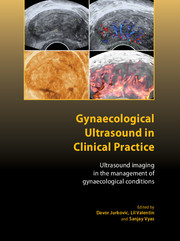 Gynaecological Ultrasound in Clinical Practice
Gynaecological Ultrasound in Clinical Practice Published online by Cambridge University Press: 05 February 2014
Introduction
Transvaginal ultrasound examination is an excellent tool for solving clinical problems in women with symptoms suggesting the presence of an adnexal mass. A gynaecologist experienced in ultrasound diagnosis using good-quality equipment is usually able to establish with confidence the nature of a pelvic tumour from its ultrasound image. This helps to individualise and optimise the management of a woman with a palpable pelvic mass.
Ultrasound morphology for discrimination between benign and malignant adnexal masses
Subjective evaluation of the greyscale ultrasound image (that is, pattern recognition) for discrimination between benign and malignant tumours can be learned by performing gynaecological ultrasound examinations on a regular basis. However, the diagnostic accuracy of subjective assessment of tumour morphology increases with increasing experience. An experienced ultrasound examiner can confidently discriminate between benign and malignant pelvic tumours in the adnexal region using pattern recognition. The reported sensitivity of pattern recognition varies between 88% and 100% and the reported specificity between 62% and 96%. Pattern recognition has been shown to be superior to all other ultrasound methods (such as simple classification systems, scoring systems or mathematical models for calculating the risk of malignancy) for discrimination between benign and malignant extrauterine pelvic masses. Adding Doppler ultrasound examination to subjective evaluation of the greyscale ultrasound image does not seem to yield much improvement in diagnostic precision, but it may increase the confidence with which a correct diagnosis of benignity or malignancy is made.
To save this book to your Kindle, first ensure [email protected] is added to your Approved Personal Document E-mail List under your Personal Document Settings on the Manage Your Content and Devices page of your Amazon account. Then enter the ‘name’ part of your Kindle email address below. Find out more about saving to your Kindle.
Note you can select to save to either the @free.kindle.com or @kindle.com variations. ‘@free.kindle.com’ emails are free but can only be saved to your device when it is connected to wi-fi. ‘@kindle.com’ emails can be delivered even when you are not connected to wi-fi, but note that service fees apply.
Find out more about the Kindle Personal Document Service.
To save content items to your account, please confirm that you agree to abide by our usage policies. If this is the first time you use this feature, you will be asked to authorise Cambridge Core to connect with your account. Find out more about saving content to Dropbox.
To save content items to your account, please confirm that you agree to abide by our usage policies. If this is the first time you use this feature, you will be asked to authorise Cambridge Core to connect with your account. Find out more about saving content to Google Drive.